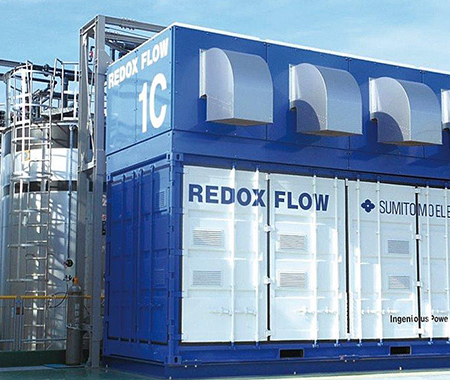
Malaviya National Institute of Technology Jaipur

Vanadium Redox-flow Battery: The Ultimate Grid Battery
The Vanadium Redox Flow Battery (VRFB) was explored in 1930’s but successfully demonstrated at the University of South Wales in the 1980’s. It has emerged recently as one of the leading contenders for large-scale energy storage.
How Large? It can be scaled to store hundreds of megawatt-hours of energy for grid scale uses. It can be charged by large base load plant which generate electricity cheaply but are too sluggish to accommodate sharp increases in demand during peak hours. Or they may be charged by renewable sources like wind farms, whose generation doesn’t always align well with demand. Like most batteries, VRFBs can deliver power nearly instantaneously, so they can stand in for the traditional means of meeting peak demand: fossil-fueled “peaker”.
Lithium-ion batteries, too, have been proposed for grid-scale uses but it has major short comings like it will require many thousands or even millions of Li-ion cells, each of which needs to be managed individually as well as collectively with the other cells capable of storing megawatt-hours. Even then, Li-ion batteries can supply power over only relatively short durations, typically 2 hours or less. The performance of a Li-ion battery also degrades over time, giving the battery a typical lifetime of 10 years or so. That may be fine for a family car but is less desirable for use on the power grid. And Li-ion batteries have known safety issues, most notably the occasional explosion or spontaneous fire
On the other hand, VRFB have longer lifetimes, VRFBcan be scaled up more easily, and can operate day in, day out, with no significant performance loss for 20 years or more be much safer, if built around nonflammable materials. Soon this technology will be the cornerstone of the largest battery installation in the world: a 200-MW, 800-megawatt-hour storage station being built in Dalian. The first 100 MW will be installed by the end of this year, with the remainder coming on line in 2018.

According to the U.S. Department of Energy’s global energy storage database, since 2014, more than 30 VRFB projects in 11 countries have been deployed or begun construction; these range in power from a few tens of kilowatts up to Dalian’s 200 MW. While these projects reflect the surging interest in all forms of energy storage, what’s driving the renewed push toward VRFBs are important technological distinctions! Read more about VRFB by following the links below:
https://spectrum.ieee.org/green-tech/fuel-cells/its-big-and-longlived-and-it-wont-catch-fire-the-vanadium-redoxflow-battery.
NOVEMBER 13, 2017 AKANKSHASHUKLA19